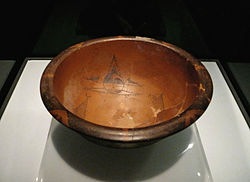Banpo
Archaeological site in Shaanxi, China From Wikipedia, the free encyclopedia
Banpo is a Neolithic archaeological site located in the Yellow River valley, east of present-day Xi'an, China. Discovered in 1953 by Shi Xingbang,[1] the site represents the first phase of the Yangshao culture (c. 5000 – c. 3000 BCE) and features the remains of several well organized settlements—including Jiangzhai, which has been radiocarbon dated to c. 4700 – c. 3600 BCE).[2][3][4][5] An area of 5 to 6 hectares (12 to 15 acres) was surrounded by a ditch, probably a defensive moat 5 to 6 meters (16 to 20 ft) wide. The houses at Banpo were circular, built of mud and wood on low foundations, with overhanging thatched roofs. There also appear to have been communal burials.[6]
半坡 | |
 Reconstructed diorama of a village at Banpo | |
| Location | Shaanxi, China |
|---|---|
| Coordinates | 34.273°N 109.051°E |
| Type | Settlement |
| History | |
| Founded | c. 4700 BC |
| Abandoned | c. 3600 BC |
| Periods | Neolithic China |
| Cultures | Yangshao culture |
| Site notes | |
| Discovered | 1953 by Shi Xingbang |
Site
The settlement was surrounded by a moat, with the graves and pottery kilns located outside the moat perimeter. Many of the houses were semi-subterranean with the floor typically 1 meter (3 ft) below the ground surface. The houses were supported by timber poles and had steeply pitched thatched roofs.
According to the paradigm of archaeology influenced by Marxist historiography that was prevalent in China at the time the site was being excavated, Banpo society was considered to be matriarchal; however, new research contradicts this claim and the Marxist paradigm is gradually being phased out in modern Chinese archaeological research.[7] The archaeological evidence to date has not allowed for deeper insight or analysis concerning the religious or political structure of Banpo society.[6][8]
The site is now home to the Xi'an Banpo Museum, built in 1957 to preserve the archaeological collection.[9]
Banpo culture
Summarize
Perspective
Banpo is the type site of the Banpo culture, first phase of the Yangshao Culture. Archaeological sites with similarities to the site at Banpo are considered to be part of the "Banpo phase" (4th-3rd millennium BCE) of the Yangshao culture. Banpo was excavated from 1954 to 1957.
The tomb of a four-year-old girl contains one of the earliest examples of children's toys, a set of three stone balls.[10]
Pottery innovations
Banpo was the first culture to use the potter's wheel in China, while other cultures continued to use coiling techniques, and the potter's wheel only became generalized by the end of the Yangshao period.[11] Banpo also had the first pottery kilns in China.[11] The designs of the Banpo were often geometric, and animal or anthropomorphic figures.[11]
- Banpo pottery kiln
- Banpo pottery made on a potter's wheel
Designs

Banpo is known for a characteristic type of decorative pottery, with a red clay coating all over the body, and geometrical drawings in black, typically depicting a round human head with some fish around it. The round human head had a triangular design on top.[12] Similarities have been noted between the motifs of the Afanasievo culture and Okunev culture of the Minusinsk basin in Siberia, and those on the potteries of Banpo.[13] Pottery style emerging from the Yangshao culture spread westward to the Majiayao culture, and then further to Xinjiang and Central Asia.[14]
Several of the potteries have symbol marks, and are part of the Neolithic signs in China, but each sign occurs singly, which is antinomic with the function of a written script. They could instead be the personal mark of individual potters.
- Pottery pot with human and fish design, Shaanxi province. Beijing Capital Museum
- Human faced–fish decorated bowl recovered at Banpo.
- Banpo anthropomorphic motif
- Banpo burial
- A skull recovered at Banpo displayed at the Xi'an Banpo Museum.
- Banpo pottery symbols
See also
Footnotes
References
Wikiwand - on
Seamless Wikipedia browsing. On steroids.










